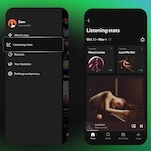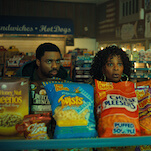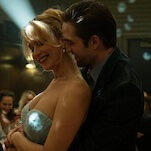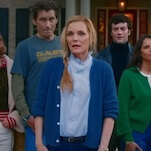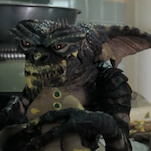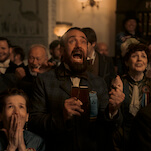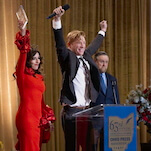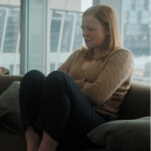It’s strange to root for Fiona Wallice, but right on cue, I do. Web Therapy was conceived to mock the kinds of people who would try to get their therapy out of the way in three-minute sessions over Skype, but in execution, it’s been primarily about degrading the creators, Lisa Kudrow’s shameless Fiona and Dan Bucatinsky’s servile Jerome. The people on the other end of the chat are basically normal people that Fiona sees through, rarely worth rooting against even when they’re openly dismissive of our antihero. In season two, however, the tables are turned in a few respects. The first is that Fiona is often the one engaging in a therapeutic working-through of her feelings, consciously or not. Another is that the people she talks to are shameless and stupid and hateful, too, and in a way, even more so. But Fiona has a penchant for eventually dominating every opponent such that, given enough time, her contacts end up supporting her or wanting something from her or giving up. In season one, that felt like a commentary on the kinds of people who relentlessly pursue mini-trainwreck fame (think MTV reality show stars) and succeed through endurance. In season two, it’s a fist-pump moment when Fiona gets that farewell dig in at Camilla: “Why don’t you just try wearing a blazer from time to time?” Fiona might actually be the hero of Web Therapy.
That’s because “Blindsides And Backslides,” like last week’s “Getting It Straight,” pits Fiona against a destructive religious right. Fiona’s damage is limited to her sphere of influence, which, in the tradition of The Comeback, is basically herself, especially now that Kip has a whole team of advisers and Jerome will listen to anyone. She’s a nobody with no power, trying and failing to increase her station. Her conversational opponents, on the other hand, are an interconnected group of representatives of powerful entrenched interests, seeking primarily to pretend homosexuality doesn’t exist and shape the world in that image. The vertical integration of these stories is a brilliant opportunity to explore even more of Kip’s received politics (and their potential wake) as the season goes on, but this volley against the anti-gay movement has been delightfully topical.
It’s also been a little cartoonish for a show anchored by the credible, low-key conversations between improv champs Kudrow and Bucatinsky. I don’t mean the plots. Gay reparative therapy is equally absurd, albeit much sadder. But Rosie O’Donnell’s Maxine is not a stinging caricature built out of observational detail. She holds rosary beads and smiles with superiority at the failings of non-Catholics. GCB had more teeth. And as much as I love hearing Meryl Streep traffic in double-entendre and roll her eyes about gay marriage and “the downside of all that,” Camilla’s spaciness reveals itself in “Blindsides And Backslides” to be performative aimlessness. Streep has some great ideas (see: Camilla looking off-screen to confirm that Kip is due for hands-on therapy), just not a sharp, three-dimensional portrait. It’s a blast to pick up details about Trent and the Compass Center (where the first thing they do with a client is drop his phone in the hot tub) and Max’s visit with Jerome (still with Rashida Jones’ Hayley, apparently), but the fuzziness of the new characters deprives them of Web Therapy’s characteristic crystal-clear exposure. Fiona gets to play hardball. Camilla and Max are still using a tee.
That’s not to say “Blindsides And Backslides” isn’t funny, or that it doesn’t still land its points. “God touches me down there” is a fascinating, loaded joke that efficiently gets into Camilla’s specific brand of proselytizing, and Fiona’s chaser (“How interesting that he taps you there when a shoulder is so available”) is beautiful. How Fiona missed the subtext in “Getting It Straight” about Camilla’s “top to toe, back and front, all around the world” technique is quite the stretch, but in Fiona’s defense, Camilla barely has the capacity for surface text. Thus, a scene that Fiona begins by insincerely thanking Camilla for her advice concludes with Fiona sarcastically thanking Camilla for her work. (Another quintessential Fiona line: “I’ve yet to have an unhappy moment.”) Even Jerome is crystallized in a quick joke during Fiona’s barrage: She tells him his participation in her book “is a contribution, a menial one,” and he immediately says, “Thank you.” The diminished trenchancy has had no effect on the laughs.
The hyperactive talking head format gets a twist when Fiona plays Maxine’s chat for Jerome, so the audience can watch Maxine extol the virtues of Fiona’s rhinoplasty while Jerome solemnly agrees and Fiona scoffs. The more Web Therapy plays with simultaneity the better. Where the political hits suffer from looseness, the everything-at-once inundation of the Internet can get as crazy as the show is willing to take it.
The chat-window format also brings out the expressive quality of the sets. Like Fiona’s blazers or Max’s rosary beads, the two-walled corners of a furniture store behind each character reveal personality. Fiona’s house is crowded with hard, structured pieces, from a studded, checkered leather headboard to a series of medium stone statues. Outside of the bathroom office, which itself is a room of cold steel and glass, the Wallices’ home feels awfully like it’s styled after a samurai. But where Fiona has hard edges and straight lines, Camilla has curves and cushions, which speaks to her rigid gender roles. She’s also situated such that her furniture points inward, everything in the image leading to her, and two lamps provide balance. Max’s office is decked out with candles and little statues of Jesus and the Virgin Mary, because that is the extent of her character. And my favorite set in the entire series is Jerome’s two walls of nothing but black file cabinets. It’d be Kafkaesque if Jerome had any self-awareness.
Stray observations:
- In other news, Fiona ostensibly breaks up with Austen this week. Hopefully we’ll see some follow-up, if just to see Alan Cumming again.
- I mentioned that Lisa Kudrow and Dan Bucatinsky are two creators of Web Therapy who star on it. The third is Don Roos, who has directed every episode. The three of them outline the stories for every episode as well. That creative stability surely earns Web Therapy a place in the conversation about auteur television.
- On the most recent episode of Aisha Tyler's podcast Girl On Guy, Lisa Kudrow talks about Web Therapy (and Friends and more). Trivia: Meryl Streep's first scene went on for almost half an hour. The magic of improv!
- Kip’s website is a beauty from the awkward banner photo to the slogan of pride: America’s On Top Again.
- Another spot-on Streep moment: When Fiona asks Camilla to doublecheck how many prongs are involved in her electricity metaphor. She takes time to think about it, then triple-checks using her fingers. I also died at her counting her children: “I have six kids!” Then, with an eye-roll, “And one adopted.” It’s not Mark Twain, but it’s funny.
- Speaking of Camilla, I was sure the two-prongs discussion was meant to foreshadow a threesome between Kip, Camilla, and Trent, but it turns out they didn’t need her.
- Quintessential Fiona Wallice: “No, I don’t like music at all.”
- Jerome thinks it’s exciting that Fiona’s going to see Spiderman: The Musical. “Is it? I just hear a lot of people get injured, so I thought it would be fun if I caught it on one of those nights.”




